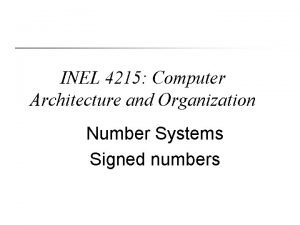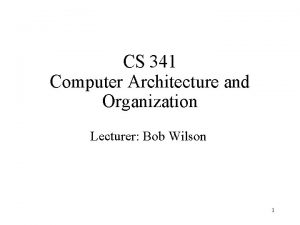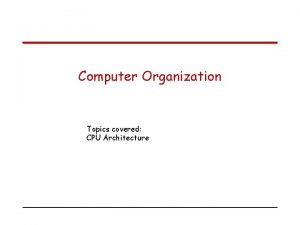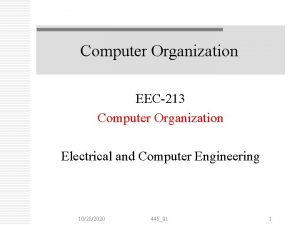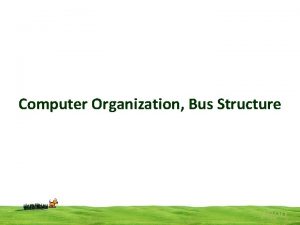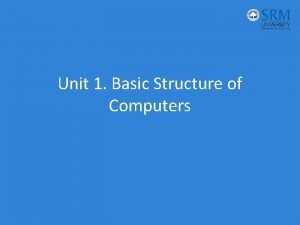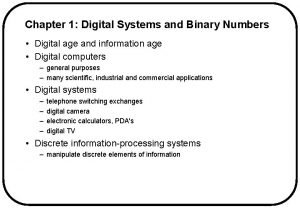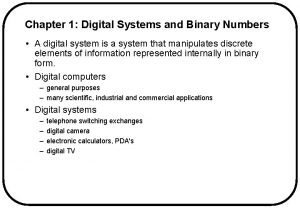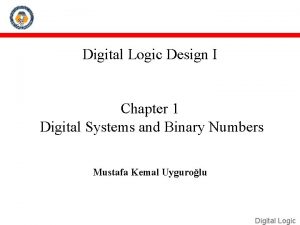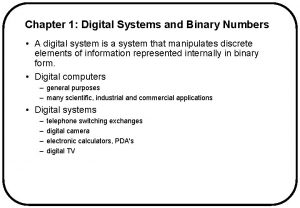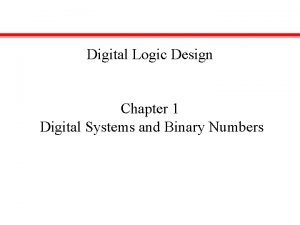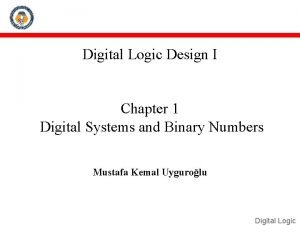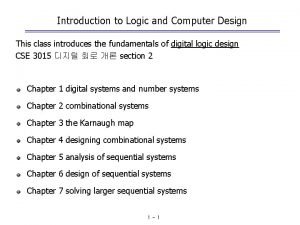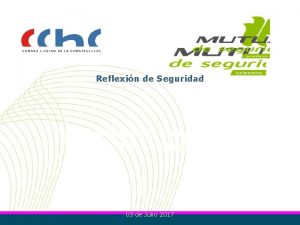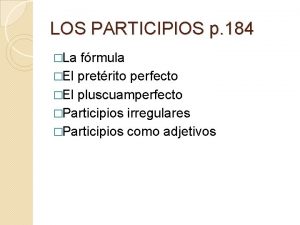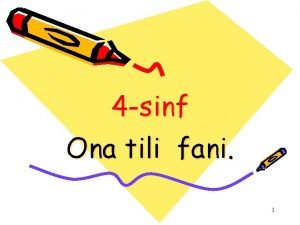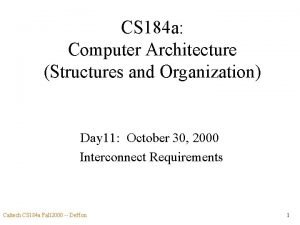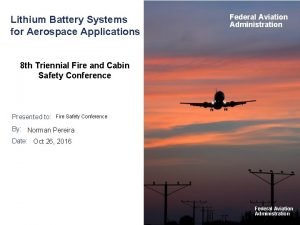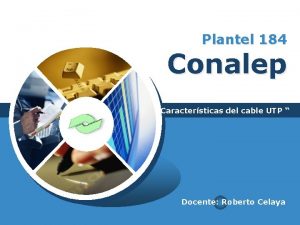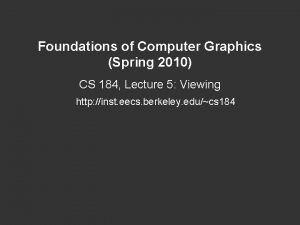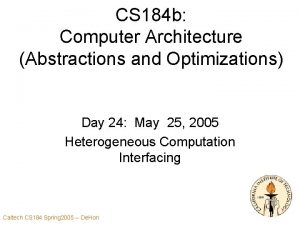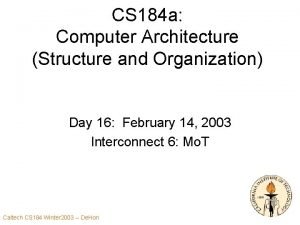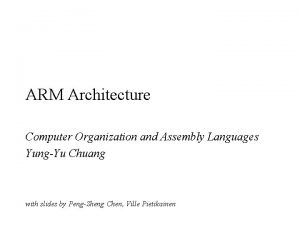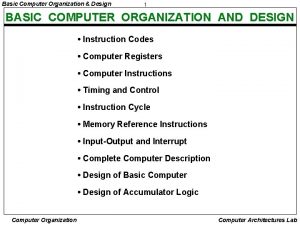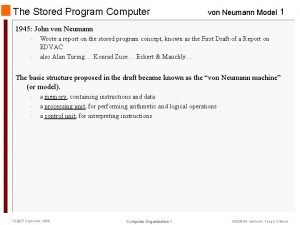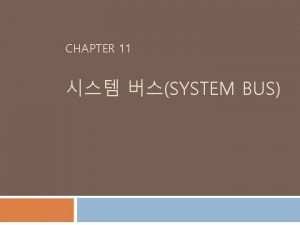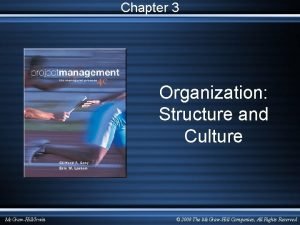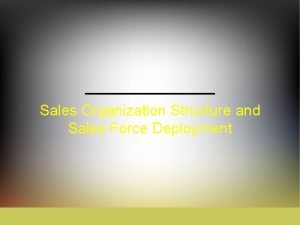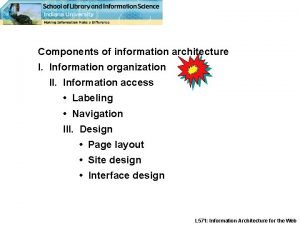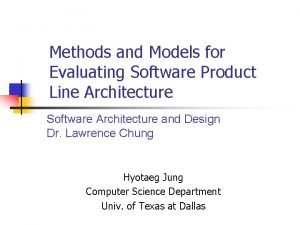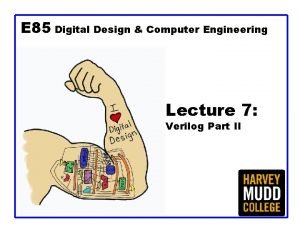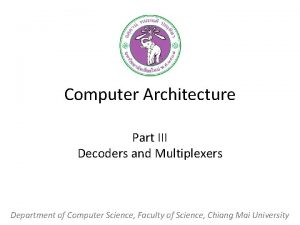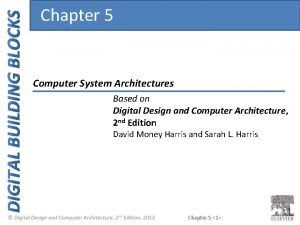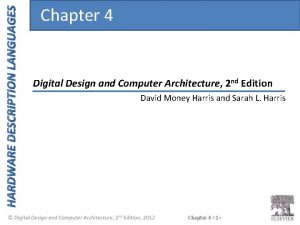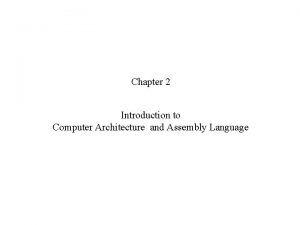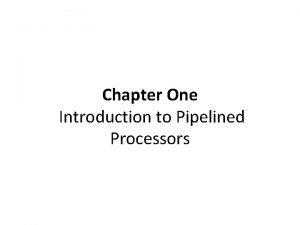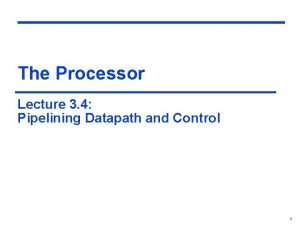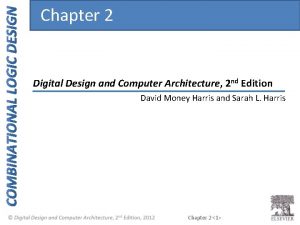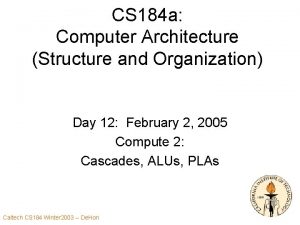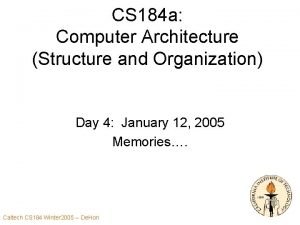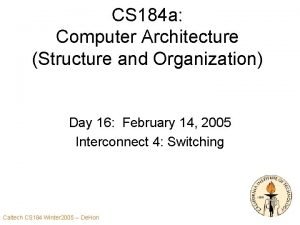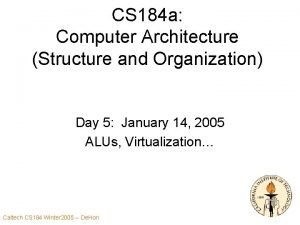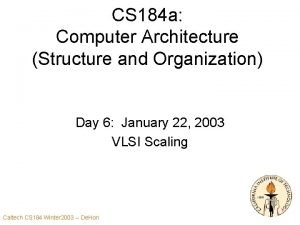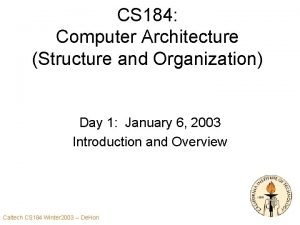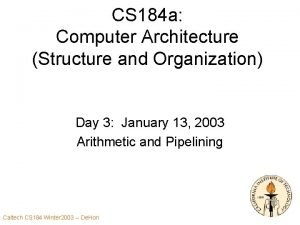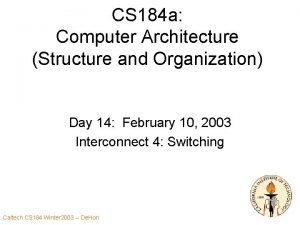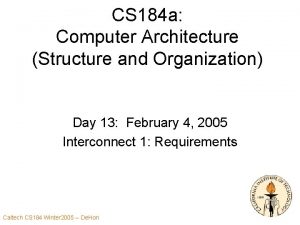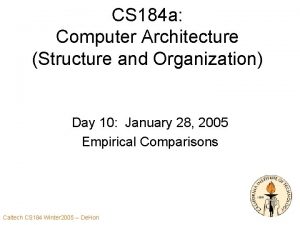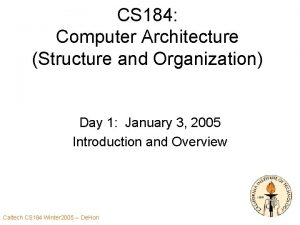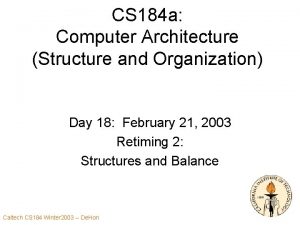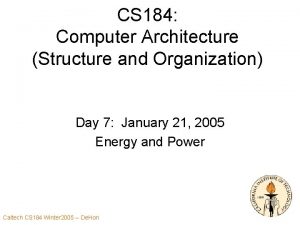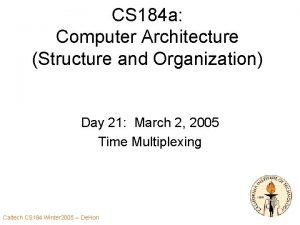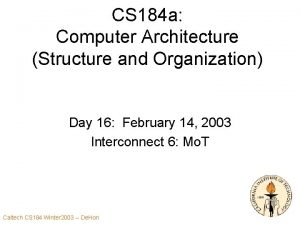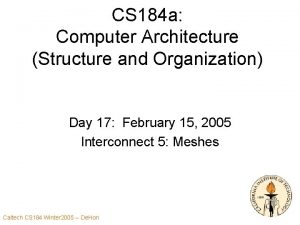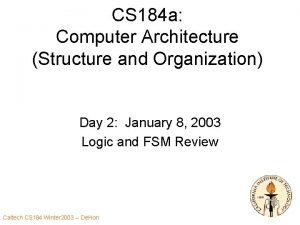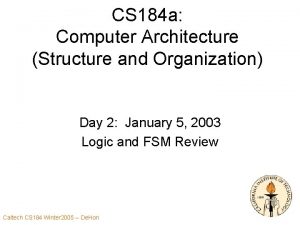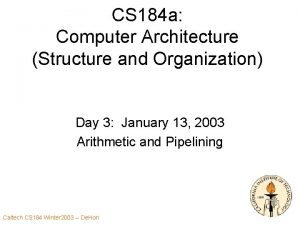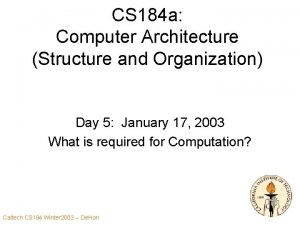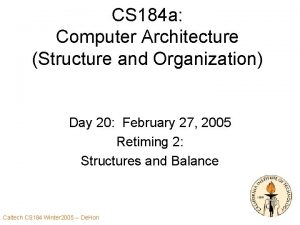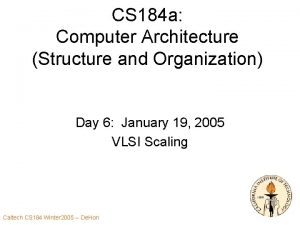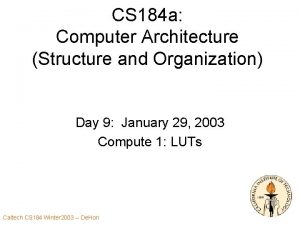CS 184 a Computer Architecture Structure and Organization







![Ripple Carry Analysis • Area: O(N) [6 n] • Delay: O(N) [2 n] Caltech Ripple Carry Analysis • Area: O(N) [6 n] • Delay: O(N) [2 n] Caltech](https://slidetodoc.com/presentation_image_h2/deb77ae29d6e9b7e323a9f581e496d81/image-8.jpg)










![Functions • What functions can g(c[i-1]) be? – g(x)=1 • a[i]=b[i]=1 – g(x)=x • Functions • What functions can g(c[i-1]) be? – g(x)=1 • a[i]=b[i]=1 – g(x)=x •](https://slidetodoc.com/presentation_image_h2/deb77ae29d6e9b7e323a9f581e496d81/image-19.jpg)
![Functions • What functions can g(c[i-1]) be? – g(x)=1 Generate • a[i]=b[i]=1 – g(x)=x Functions • What functions can g(c[i-1]) be? – g(x)=1 Generate • a[i]=b[i]=1 – g(x)=x](https://slidetodoc.com/presentation_image_h2/deb77ae29d6e9b7e323a9f581e496d81/image-20.jpg)
![Combining • Want to combine functions – Compute c[i]=gi(gi-1(c[i-2])) – Compute compose of two Combining • Want to combine functions – Compute c[i]=gi(gi-1(c[i-2])) – Compute compose of two](https://slidetodoc.com/presentation_image_h2/deb77ae29d6e9b7e323a9f581e496d81/image-21.jpg)


![Combining • Do it again… • Combine g[i-3, i-2] and g[i-1, i] • What Combining • Do it again… • Combine g[i-3, i-2] and g[i-1, i] • What](https://slidetodoc.com/presentation_image_h2/deb77ae29d6e9b7e323a9f581e496d81/image-24.jpg)















![Stagger Inputs • Correct if expecting A, B[3: 2] to be staggered one cycle Stagger Inputs • Correct if expecting A, B[3: 2] to be staggered one cycle](https://slidetodoc.com/presentation_image_h2/deb77ae29d6e9b7e323a9f581e496d81/image-40.jpg)



























![Big Ideas [MSB Ideas] • Can build arithmetic out of logic • Pipelining: – Big Ideas [MSB Ideas] • Can build arithmetic out of logic • Pipelining: –](https://slidetodoc.com/presentation_image_h2/deb77ae29d6e9b7e323a9f581e496d81/image-68.jpg)
![Big Ideas [MSB-1 Ideas] • Area-Time Tradeoff in Adders • Parallel Prefix • FSMD Big Ideas [MSB-1 Ideas] • Area-Time Tradeoff in Adders • Parallel Prefix • FSMD](https://slidetodoc.com/presentation_image_h2/deb77ae29d6e9b7e323a9f581e496d81/image-69.jpg)
- Slides: 69

CS 184 a: Computer Architecture (Structure and Organization) Day 3: January 10, 2005 Arithmetic and Pipelining Caltech CS 184 Winter 2005 -- De. Hon

Last Time • Boolean logic computing any finite function • Sequential logic computing any finite automata – included some functions of unbounded size • Saw gates and registers – …and a few properties of logic Caltech CS 184 Winter 2005 -- De. Hon

Today • Addition – organization – design space – area, time • Pipelining • Temporal Reuse – area-time tradeoffs Caltech CS 184 Winter 2005 -- De. Hon

Example: Bit Level Addition • Addition – (everyone knows how to do addition base 2, right? ) C: 11011010000 1010000 000 A: 01101101010 B: 01100101100 S: 11110010110 0010110 110 100 Caltech CS 184 Winter 2005 -- De. Hon

Addition Base 2 • A = an-1*2(n-1)+an-2*2(n-2)+. . . a 1*21+ a 0*20 = S (ai*2 i) • S=A+B • si=(xor carryi (xor ai bi)) • carryi = ( ai-1 + bi-1 + carryi-1) 2 = (or (and ai-1 bi-1) (and ai-1 carryi-1) (and bi-1 carryi-1)) Caltech CS 184 Winter 2005 -- De. Hon

Adder Bit • S=(xor a b carry) • t=(xor 2 a b); s=(xor 2 t carry) • xor 2 = (and (not (and 2 a b) (not (and 2 (not a) (not b))) • carry = (not (and 2 a b)) (and 2 (not (and 2 b carry)) (not (and 2 a carry))))) Caltech CS 184 Winter 2005 -- De. Hon

Ripple Carry Addition • Shown operation of each bit • Often convenient to define logic for each bit, then assemble: – bit slice Caltech CS 184 Winter 2005 -- De. Hon
![Ripple Carry Analysis Area ON 6 n Delay ON 2 n Caltech Ripple Carry Analysis • Area: O(N) [6 n] • Delay: O(N) [2 n] Caltech](https://slidetodoc.com/presentation_image_h2/deb77ae29d6e9b7e323a9f581e496d81/image-8.jpg)
Ripple Carry Analysis • Area: O(N) [6 n] • Delay: O(N) [2 n] Caltech CS 184 Winter 2005 -- De. Hon

Can we do better? Caltech CS 184 Winter 2005 -- De. Hon

Important Observation • Do we have to wait for the carry to show up to begin doing useful work? – We do have to know the carry to get the right answer. – But, it can only take on two values Caltech CS 184 Winter 2005 -- De. Hon

Idea • Compute both possible values and select correct result when we know the answer Caltech CS 184 Winter 2005 -- De. Hon

Preliminary Analysis • • • DRA--Delay Ripple Adder DRA(n) = k*n DRA(n) = 2*DRA(n/2) DP 2 A-- Delay Predictive Adder DP 2 A=DRA(n/2)+D(mux 2) …almost half the delay! Caltech CS 184 Winter 2005 -- De. Hon

Recurse • If something works once, do it again. • Use the predictive adder to implement the first half of the addition Caltech CS 184 Winter 2005 -- De. Hon

Recurse Redundant (can share) Caltech CS 184 Winter 2005 -- De. Hon

Recurse • If something works once, do it again. • Use the predictive adder to implement the first half of the addition • DP 4 A(n)=DRA(n/4) + D(mux 2) • DP 4 A(n)=DRA(n/4)+2*D(mux 2) Caltech CS 184 Winter 2005 -- De. Hon

Recurse • By know we realize we’ve been using the wrong recursion – should be using the DPA in the recursion • DPA(n) = DPA(n/2) + D(mux 2) • DPA(n)=log 2(n)*D(mux 2)+C Caltech CS 184 Winter 2005 -- De. Hon

Another Way (Parallel Prefix) Caltech CS 184 Winter 2005 -- De. Hon

CLA • Think about each adder bit as a computing a function on the carry in – C[i]=g(c[i-1]) – Particular function f will depend on a[i], b[i] – G=f(a, b) Caltech CS 184 Winter 2005 -- De. Hon
![Functions What functions can gci1 be gx1 aibi1 gxx Functions • What functions can g(c[i-1]) be? – g(x)=1 • a[i]=b[i]=1 – g(x)=x •](https://slidetodoc.com/presentation_image_h2/deb77ae29d6e9b7e323a9f581e496d81/image-19.jpg)
Functions • What functions can g(c[i-1]) be? – g(x)=1 • a[i]=b[i]=1 – g(x)=x • a[i] xor b[i]=1 – g(x)=0 • A[i]=b[i]=0 Caltech CS 184 Winter 2005 -- De. Hon
![Functions What functions can gci1 be gx1 Generate aibi1 gxx Functions • What functions can g(c[i-1]) be? – g(x)=1 Generate • a[i]=b[i]=1 – g(x)=x](https://slidetodoc.com/presentation_image_h2/deb77ae29d6e9b7e323a9f581e496d81/image-20.jpg)
Functions • What functions can g(c[i-1]) be? – g(x)=1 Generate • a[i]=b[i]=1 – g(x)=x Propagate • a[i] xor b[i]=1 – g(x)=0 • A[i]=b[i]=0 Caltech CS 184 Winter 2005 -- De. Hon Squash
![Combining Want to combine functions Compute cigigi1ci2 Compute compose of two Combining • Want to combine functions – Compute c[i]=gi(gi-1(c[i-2])) – Compute compose of two](https://slidetodoc.com/presentation_image_h2/deb77ae29d6e9b7e323a9f581e496d81/image-21.jpg)
Combining • Want to combine functions – Compute c[i]=gi(gi-1(c[i-2])) – Compute compose of two functions • What functions will the compose of two of these functions be? – Same as before • Propagate, generate, squash Caltech CS 184 Winter 2005 -- De. Hon

Compose Rules (LSB MSB) • • • GG GP GS PG PP PS Caltech CS 184 Winter 2005 -- De. Hon • SG • SP • SS

Compose Rules (LSB MSB) • • • GG = G GP = G GS = S PG = G PP = P PS = S Caltech CS 184 Winter 2005 -- De. Hon • SG = G • SP = S • SS = S
![Combining Do it again Combine gi3 i2 and gi1 i What Combining • Do it again… • Combine g[i-3, i-2] and g[i-1, i] • What](https://slidetodoc.com/presentation_image_h2/deb77ae29d6e9b7e323a9f581e496d81/image-24.jpg)
Combining • Do it again… • Combine g[i-3, i-2] and g[i-1, i] • What do we get? Caltech CS 184 Winter 2005 -- De. Hon

Reduce Tree Caltech CS 184 Winter 2005 -- De. Hon

Prefix Tree Caltech CS 184 Winter 2005 -- De. Hon

Parallel Prefix • Important Pattern • Applicable any time operation is associative • Function Composition is always associative Caltech CS 184 Winter 2005 -- De. Hon

Note: Constants Matter • Watch the constants • Asymptotically this RPA is great • For small adders can be smaller with – fast ripple carry – larger combining than 2 -ary tree – mix of techniques • …will depend on the technology primitives and cost functions Caltech CS 184 Winter 2005 -- De. Hon

Two’s Complement • Everyone seemed to know Two’s complement • 2’s complement: – positive numbers in binary – negative numbers • subtract 1 and invert • (or invert and add 1) Caltech CS 184 Winter 2005 -- De. Hon

Two’s Complement • 2 = 010 • 1 = 001 • 0 = 000 • -1 = 111 • -2 = 110 Caltech CS 184 Winter 2005 -- De. Hon

Addition of Negative Numbers? • …just works A: 111 B: 001 S: 000 Caltech CS 184 Winter 2005 -- De. Hon A: 110 B: 001 S: 111 A: 111 B: 010 S: 001 A: 111 B: 110 S: 101

Subtraction • Negate the subtracted input and use adder – which is: • invert input and add 1 • works for both positive and negative input – 001 110 +1 = 111 – 111 000 +1 = 001 – 000 111 +1 = 000 – 010 101 +1 = 110 – 110 001 +1 = 010 Caltech CS 184 Winter 2005 -- De. Hon

Subtraction (add/sub) • Note: you can use the “unused” carry input at the LSB to perform the “add 1” Caltech CS 184 Winter 2005 -- De. Hon

Overflow? A: 111 B: 001 S: 000 A: 001 B: 001 S: 010 A: 110 B: 001 S: 111 A: 011 B: 001 S: 100 A: 111 B: 010 S: 001 A: 111 B: 100 S: 011 • Overflow=(A. s==B. s)*(A. s!=S. s) Caltech CS 184 Winter 2005 -- De. Hon A: 111 B: 110 S: 101

Reuse Caltech CS 184 Winter 2005 -- De. Hon

Reuse • In general, we want to reuse our components in time – not disposable logic • How do we do that? – Wait until done, someone’s used output Caltech CS 184 Winter 2005 -- De. Hon

Reuse: “Waiting” Discipline • Use registers and timing (or acknowledgements) for orderly progression of data Caltech CS 184 Winter 2005 -- De. Hon

Example: 4 b Ripple Adder • Recall 2 gates/FA • Latency: 8 gates to S 3 • Throughput: 1 result / 8 gate delays max Caltech CS 184 Winter 2005 -- De. Hon

Can we do better? Caltech CS 184 Winter 2005 -- De. Hon
![Stagger Inputs Correct if expecting A B3 2 to be staggered one cycle Stagger Inputs • Correct if expecting A, B[3: 2] to be staggered one cycle](https://slidetodoc.com/presentation_image_h2/deb77ae29d6e9b7e323a9f581e496d81/image-40.jpg)
Stagger Inputs • Correct if expecting A, B[3: 2] to be staggered one cycle behind A, B[1: 0] • …and succeeding stage expects S[3: 2] staggered from S[1: 0] Caltech CS 184 Winter 2005 -- De. Hon

Align Data / Balance Paths Good discipline to line up pipe stages in diagrams. Caltech CS 184 Winter 2005 -- De. Hon

Example: 4 b RA pipe 2 • Recall 2 gates/FA • Latency: 8 gates to S 3 • Throughput: 1 result / 4 gate delays max Caltech CS 184 Winter 2005 -- De. Hon

Deeper? • Can we do it again? • What’s our limit? • Why would we stop? Caltech CS 184 Winter 2005 -- De. Hon

More Reuse • Saw could pipeline and reuse FA more frequently • Suggests we’re wasting the FA part of the time in non-pipelined Caltech CS 184 Winter 2005 -- De. Hon

More Reuse (cont. ) • If we’re willing to take 8 gate-delay units, do we need 4 FAs? Caltech CS 184 Winter 2005 -- De. Hon

Ripple Add (pipe view) Can pipeline to FA. If don’t need throughput, reuse FA on SAME addition. Caltech CS 184 Winter 2005 -- De. Hon

Bit Serial Addition Assumes LSB first ordering of input data. Caltech CS 184 Winter 2005 -- De. Hon

Bit Serial Addition: Pipelining • Latency: 8 gate delays • Throughput: 1 result / 10 gate delays • Can squash Cout[3] and do in 1 result/8 gate delays • registers do have time overhead – setup, hold time, clock jitter Caltech CS 184 Winter 2005 -- De. Hon

Multiplication • Can be defined in terms of addition • Ask you to play with implementations and tradeoffs in homework 2 Caltech CS 184 Winter 2005 -- De. Hon

Compute Function • Compute: y=Ax 2 +Bx +C • Assume – D(Mpy) > D(Add) – A(Mpy) > A(Add) Caltech CS 184 Winter 2005 -- De. Hon

Spatial Quadratic • D(Quad) = 2*D(Mpy)+D(Add) • Throughput 1/(2*D(Mpy)+D(Add)) • A(Quad) = 3*A(Mpy) + 2*A(Add) Caltech CS 184 Winter 2005 -- De. Hon

Pipelined Spatial Quadratic • D(Quad) = 3*D(Mpy) • Throughput 1/D(Mpy) • A(Quad) = 3*A(Mpy) + 2*A(Add)+6 A(Reg) Caltech CS 184 Winter 2005 -- De. Hon

Bit Serial Quadratic • • data width w; one bit per cycle roughly 1/w-th the area of pipelined spatial roughly 1/w-th the throughput latency just a little larger than pipelined Caltech CS 184 Winter 2005 -- De. Hon

Quadratic with Single Multiplier and Adder? • We’ve seen reuse to perform the same operation – pipelining – bit-serial, homogeneous datapath • We can also reuse a resource in time to perform a different role. – Here: x*x, A*(x*x), B*x – also: (Bx)+c, (A*x*x)+(Bx+c) Caltech CS 184 Winter 2005 -- De. Hon

Quadratic Datapath • Start with one of each operation • (alternatives where build multiply from adds…e. g. homework) Caltech CS 184 Winter 2005 -- De. Hon

Quadratic Datapath • Multiplier servers multiple roles – x*x – A*(x*x) – B*x • Will need to be able to steer data (switch interconnections) Caltech CS 184 Winter 2005 -- De. Hon

Quadratic Datapath • Multiplier servers multiple roles – x*x – A*(x*x) – B*x • x, x*x • x, A, B Caltech CS 184 Winter 2005 -- De. Hon

Quadratic Datapath • Multiplier servers multiple roles – x*x – A*(x*x) – B*x • x, x*x • x, A, B Caltech CS 184 Winter 2005 -- De. Hon

Quadratic Datapath • Adder servers multiple roles – (Bx)+c – (A*x*x)+(Bx+c) • one always mpy output • C, Bx+C Caltech CS 184 Winter 2005 -- De. Hon

Quadratic Datapath Caltech CS 184 Winter 2005 -- De. Hon

Quadratic Datapath • Add input register for x Caltech CS 184 Winter 2005 -- De. Hon

Quadratic Control • Now, we just need to control the datapath • Control: – LD x*x – MA Select – MB Select – AB Select – LD Bx+C – LD Y Caltech CS 184 Winter 2005 -- De. Hon

FSMD • FSMD = FSM + Datapath • Stylization for building controlled datapaths such as this (a pattern) • Of course, an FSMD is just an FSM – it’s often easier to think about as a datapath – synthesis, AP&R tools have been notoriously bad about discovering/exploiting datapath structure Caltech CS 184 Winter 2005 -- De. Hon

Quadratic FSMD Caltech CS 184 Winter 2005 -- De. Hon

Quadratic FSMD Control • S 0: if (go) LD_X; goto S 1 – else goto S 0 • S 1: MA_SEL=x, MB_SEL[1: 0]=x, LD_x*x – goto S 2 • S 2: MA_SEL=x, MB_SEL[1: 0]=B – goto S 3 • S 3: AB_SEL=C, MA_SEL=x*x, MB_SEL=A – goto S 4 • S 4: AB_SEL=Bx+C, LD_Y – goto S 0 Caltech CS 184 Winter 2005 -- De. Hon

Quadratic FSMD Control • S 0: if (go) LD_X; goto S 1 – else goto S 0 • S 1: MA_SEL=x, MB_SEL[1: 0]=x, LD_x*x – goto S 2 • S 2: MA_SEL=x, MB_SEL[1: 0]=B – goto S 3 • S 3: AB_SEL=C, MA_SEL=x*x, MB_SEL=A – goto S 4 • S 4: AB_SEL=Bx+C, LD_Y – goto S 0 Caltech CS 184 Winter 2005 -- De. Hon

Quadratic FSM • Latency: 5*(D(MPY)+D(mux 3)) • Throughput: 1/Latency • Area: A(Mpy)+A(Add)+5*A(Reg) +2*A(Mux 2)+A(Mux 3)+A(QFSM) Caltech CS 184 Winter 2005 -- De. Hon
![Big Ideas MSB Ideas Can build arithmetic out of logic Pipelining Big Ideas [MSB Ideas] • Can build arithmetic out of logic • Pipelining: –](https://slidetodoc.com/presentation_image_h2/deb77ae29d6e9b7e323a9f581e496d81/image-68.jpg)
Big Ideas [MSB Ideas] • Can build arithmetic out of logic • Pipelining: – increases parallelism – allows reuse in time (same function) • Control and Sequencing – reuse in time for different functions • Can tradeoff Area and Time Caltech CS 184 Winter 2005 -- De. Hon
![Big Ideas MSB1 Ideas AreaTime Tradeoff in Adders Parallel Prefix FSMD Big Ideas [MSB-1 Ideas] • Area-Time Tradeoff in Adders • Parallel Prefix • FSMD](https://slidetodoc.com/presentation_image_h2/deb77ae29d6e9b7e323a9f581e496d81/image-69.jpg)
Big Ideas [MSB-1 Ideas] • Area-Time Tradeoff in Adders • Parallel Prefix • FSMD control style Caltech CS 184 Winter 2005 -- De. Hon
 Difference between architecture and organisation
Difference between architecture and organisation Basic structure of a computer system
Basic structure of a computer system Computer organization and architecture 10th solution
Computer organization and architecture 10th solution Virtual lab computer organization
Virtual lab computer organization Introduction to computer organization and architecture
Introduction to computer organization and architecture Spec rating formula in computer organization
Spec rating formula in computer organization Computer organization and architecture 10th edition
Computer organization and architecture 10th edition Computer arithmetic
Computer arithmetic Computer organisation and architecture
Computer organisation and architecture What is 1s complement
What is 1s complement Computer architecture and organization
Computer architecture and organization Process organization in computer organization
Process organization in computer organization Bus architecture in computer organization
Bus architecture in computer organization Instruction set architecture in computer organization
Instruction set architecture in computer organization Memory organization in computer architecture
Memory organization in computer architecture Basic computer design
Basic computer design Simple computer design
Simple computer design Single bus structure in computer organization
Single bus structure in computer organization Single bus structure in computer organization
Single bus structure in computer organization Three bus structure in computer organization
Three bus structure in computer organization The basic structure of computer was developed by
The basic structure of computer was developed by ?3305501049 0000 28|.|091 27|.|071 98|.|553 102|.|311 13`
?3305501049 0000 28|.|091 27|.|071 98|.|553 102|.|311 13` Rh nomenclature
Rh nomenclature Binary code example
Binary code example Bcd addition of 184 and 576
Bcd addition of 184 and 576 Digital systems and binary numbers
Digital systems and binary numbers Bcd addition of 184 and 576
Bcd addition of 184 and 576 Bcd addition of 184 and 576
Bcd addition of 184 and 576 Bcd addition of 184 and 576
Bcd addition of 184 and 576 Organization by point
Organization by point Articulo 184 bis codigo del trabajo
Articulo 184 bis codigo del trabajo Haber en participio
Haber en participio Signing naturally 4:1
Signing naturally 4:1 329 mashq
329 mashq 4 184 joules
4 184 joules Cs 184
Cs 184 Cs 184
Cs 184 Rtca do-347
Rtca do-347 Dispositivos disimiles y similares
Dispositivos disimiles y similares Cs 184 berkeley
Cs 184 berkeley (7 − 13) · (192 − 184).
(7 − 13) · (192 − 184). 184 bao
184 bao Tck 184
Tck 184 Art 188 lgt
Art 188 lgt Rua diogo moreira 184
Rua diogo moreira 184 Cs 184
Cs 184 Cs184
Cs184 Arm architecture and organization
Arm architecture and organization Interrupt cycle flow chart
Interrupt cycle flow chart Basic computer design
Basic computer design Memory locations and addresses in computer organization
Memory locations and addresses in computer organization Synchronous and asynchronous bus in computer organization
Synchronous and asynchronous bus in computer organization Return architecture
Return architecture Sales organization structure and sales force deployment
Sales organization structure and sales force deployment Organizational culture diagnosis worksheet
Organizational culture diagnosis worksheet Salesforce sales organization structure
Salesforce sales organization structure Information architecture organization schemes
Information architecture organization schemes Bapo business architecture process organization
Bapo business architecture process organization Timing and control in computer architecture
Timing and control in computer architecture Evolution of computer architecture
Evolution of computer architecture Digital design and computer architecture
Digital design and computer architecture Difference between linear and nonlinear pipeline processors
Difference between linear and nonlinear pipeline processors Digital design and computer architecture
Digital design and computer architecture What is mux in computer architecture
What is mux in computer architecture Digital design and computer architecture
Digital design and computer architecture Digital design and computer architecture
Digital design and computer architecture Assembly language computer architecture
Assembly language computer architecture Hazard detection and resolution in computer architecture
Hazard detection and resolution in computer architecture Pipelined datapath and control in computer architecture
Pipelined datapath and control in computer architecture Bubble pushing example
Bubble pushing example









